Now that the Fall season is rapidly approaching, it is time to get the Bush Hog rotary cutter into shape, as there are many acres to be cut in the upcoming months. After greasing and inspecting the various components of the rotary cutter, the most common maintenance task is to sharpen the blades of the cutter.Â
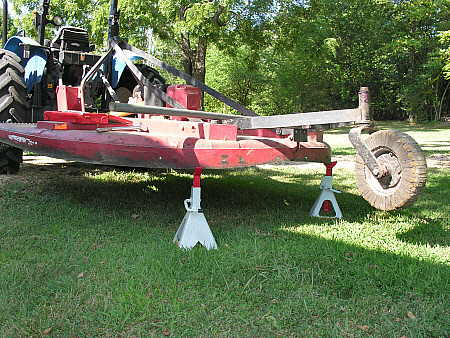
During the course of cutting pastures and fields the blades of the rotary cutter will become worn and dull, primarily from impact with rocks (see previous post entitled Dang Rocks!).   You can see what a worn rotary cutter blade edge looks like in the following photograph.
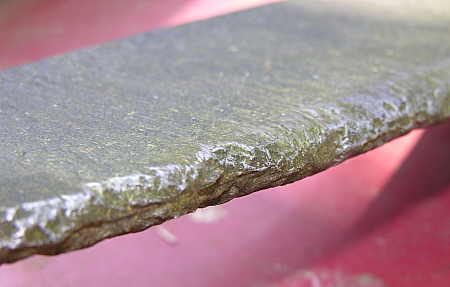
Before working underneath the rotary cutter, I would like you to take a look at the upper link assembly of the three-point hitch, which is the means of attaching the cutter to the tractor. At the top of the link assembly you can see a bolt which acts as a pivot for the upper link arm. This bolt is prone to breakage. When it breaks, the entire rear portion of the rotary cutter comes crashing down to the ground. If you happen to be underneath this rotary cutter (which weighs 1247 pounds) when this bolt snaps, it would certainly ruin your day!
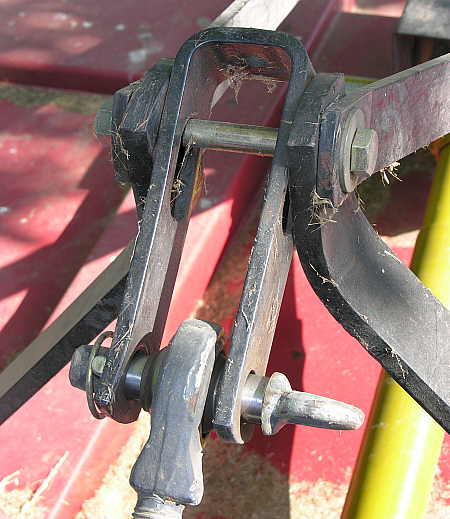
To prevent the possibility of an accident occurring when working under or around the rotary cutter, I use several heavy-duty axle stands to support the implement, as shown in the photograph below.
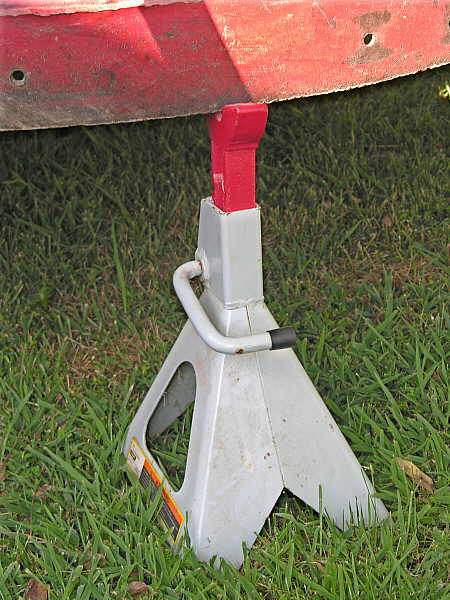
Once the cutter is properly braced, the next step is to remove the two blades from the flywheel. In the next photograph you can see that the manufacturer has provided an access hole for the blade bolts at the top of the cutter. This is a sturdy and massive 1-3/4″ bolt, which requires the use of a heavy duty socket set.
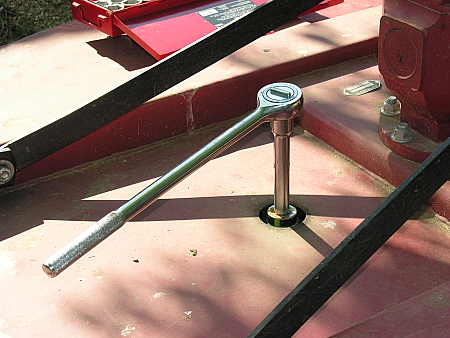
In order to even begin to budge this bolt, brains must take precedence over brawn, and so you see me resort to the use of a “cheater” bar to coax the retainer bolt into submission.
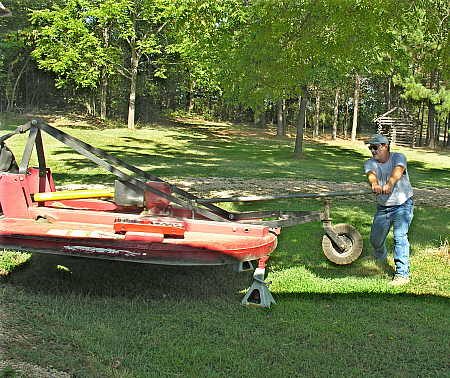
Eventually, the nut for this large retainer bolt will loosen and come off, but the bolt itself will be firmly stuck in the flywheel of the rotary cutter. At this point, a sledge hammer and a length of galvanized pipe can usually persuade the stubborn bolt to part ways with the flywheel.
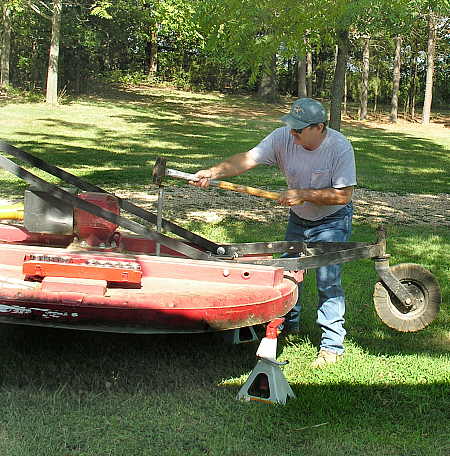
The photograph below gives a good indication of the size of the rotary cutter blades. Each blade is 5/16″ thick and weighs in excess of 20 pounds. The blade on the left is the blade that has just been removed from the cutter, and the blade on the right is a sharpened replacement blade.
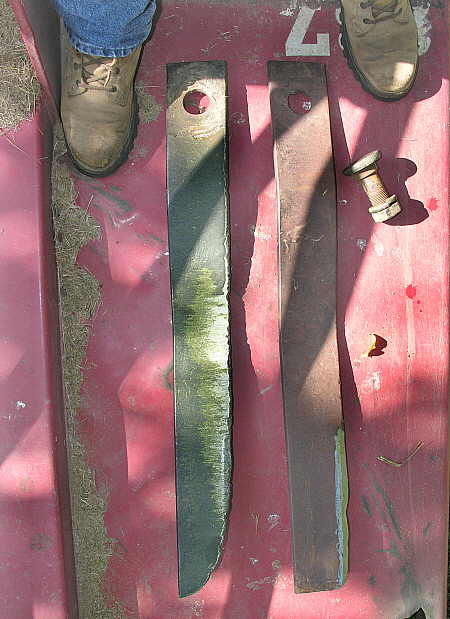
Sharpening the blades is a simple matter of running the cutting edge along the surface of a grinding wheel, as shown below.
 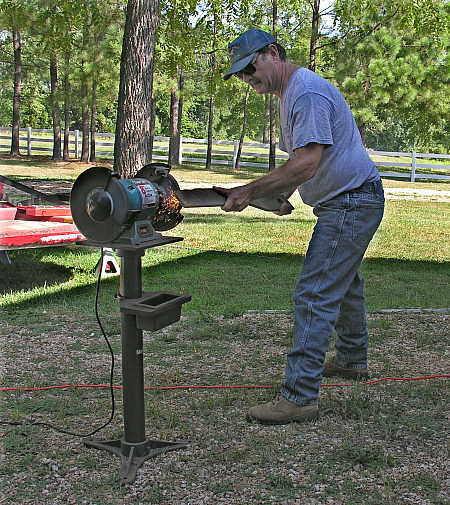
While it is not necessary for the two blades on the opposing sides of the flywheel to be exactly equal in weight after sharpening, they must be reasonably close to avoid unnecessary vibration and premature wear to the rotary cutter gearbox. To achieve this result, I use a simple self-devised method. I hang each blade from the end of a bungee cord and measure the amount of stretch that the bungee cord undergoes. When the cord stretches an equal distance for both blades, than I know that they are approximately the same weight.
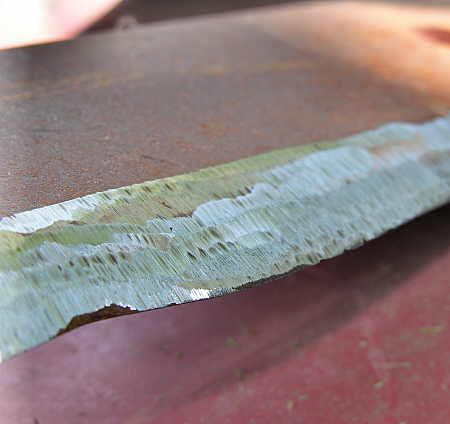
The photograph above shows the sharp edge that is obtained from grinding the rotary cutter blades. It is not as clean looking and smooth as a kitchen knife, to be sure, but it is now plenty sharp enough to tackle the grasses, weeds and brush in the pastures and fields scattered around our property.
Now that the blades are reasonably sharp and balanced, the only thing left to do is re-assemble the blades onto the flywheel of the rotary cutter. This is a simple task, however it is now that you are required to venture underneath the implement to install the blades. I always double-check the axle stands before sliding underneath the cutter, and as the photo below shows, I make it a point to coat the bolt with a good anti-seize compound before re-assembly.
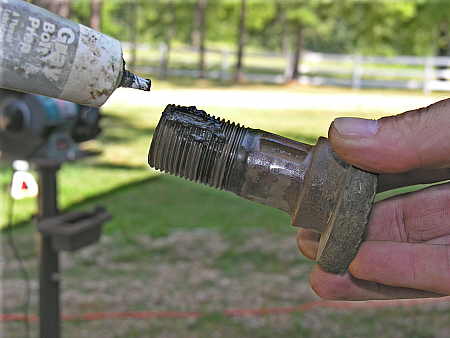
Now that I have finished sharpening the rotary cutter blades, it’s time to fuel the tractor and go bush-hog some fields. Adios, amigos.



nicely informative. the persuader bar photo really gives a person the feel for the effort involved in taking off the blades.
k-)
Bushhoggers here must have it easy. We just don’t have rocks to prematurely dull a blade. Go have some ice tea, you earned it!
Very educational!
I never thought of using a bungee cord. neat.
I think we sharpen the blades of our bush hog about once every three or four years. Fortunately, we don’t have the rocks that you have down there. Instead of a jack stands, I just use short chunks of old railroad ties which are what we use for all our jack stand needs on the farm.
Anyone got tips on an easy, yet safe way to tighten up the bush hog gearbox?
Alex – I would like to find an easy way to do this also.
My current method involves the removal of the (extremely) heavy flywheel from beneath the cutter, in order to gain access to the gearbox bolts. I set up cinder blocks on either side of the cutter, on which I place a pair of 2×4’s that I locate just below the flywheel. I can then crawl under the cutter to remove the flywheel, which is now supported by the 2×4’s (and therefore will not crush me). This gives me access to the gearbox bolts for tightening.
There is another method that I have seen in use, but not tried myself. Remove the top link of the three-point hitch from the rotary cutter, and then use a “come-along” type cable winch attached to the tractor’s ROPS (or a stout overhead beam) to elevate the cutter into a vertical attitude. This will allow you to remove the flywheel without having to lay down beneath it.
PS to the last comment – Before tightening the gearbox bolts, I remove the nuts completely and apply a good dose of Locktite to them before reassembly. This helps them remain firmly tightened, so you will not have to repeat the procedure again in the near future.
Hal,
I have been helping my 83 year old dad with some clean up around his farm. Today, I commence to start up his old 1963 MF35 and attached the model 502 Bush Hog. Well it had been a few years since I had hooked up the monstor but I finally got it on the tractor and going. Likr you, I greased and added oil to the gearbox and then went to the field. I made one round(hit a stump) and broke a blade. Well, no worries as it happened arond 10am and the local farm tractor dealer was open until noon. He had a new blade. Picked it up and then my day became a living nightmare! I will not bore you with all of the details but the end result was two broken socket wrenches and a nut that will not turn at all!. By the way I did use a cheater bar and a sledge hammer. I finally just gave up and returned the monstor to its cage! When you mention a heavy duty socket set, what do you consider heavy duty? I also sparyed a whole can of WD40 to try and loosen the nut.So, any ideas on how I can budge this nut would be helpful. I ask dad if he had ever replaced or sharpened the blades and you could not ever remember doing it! This means that these blades have been on forever. So, now I know I have to go ahead and get a second new blade as well and put it on. Just shoot me now!